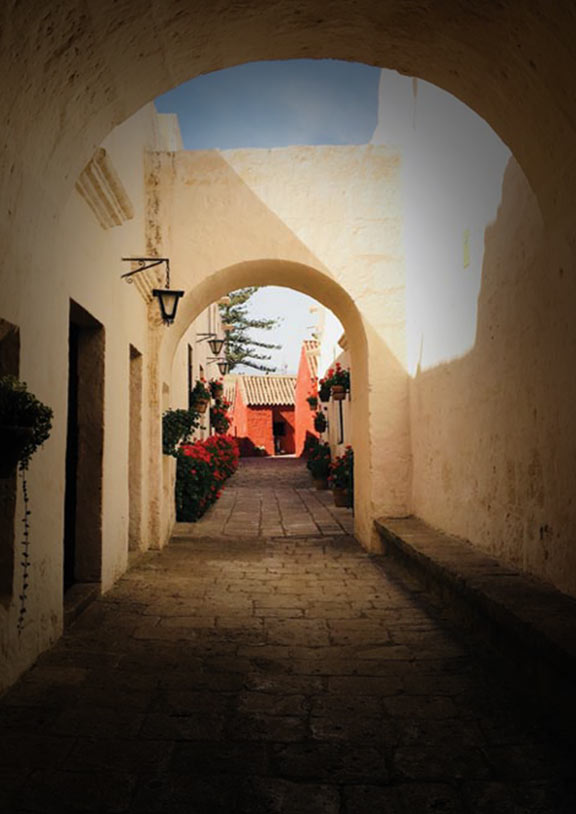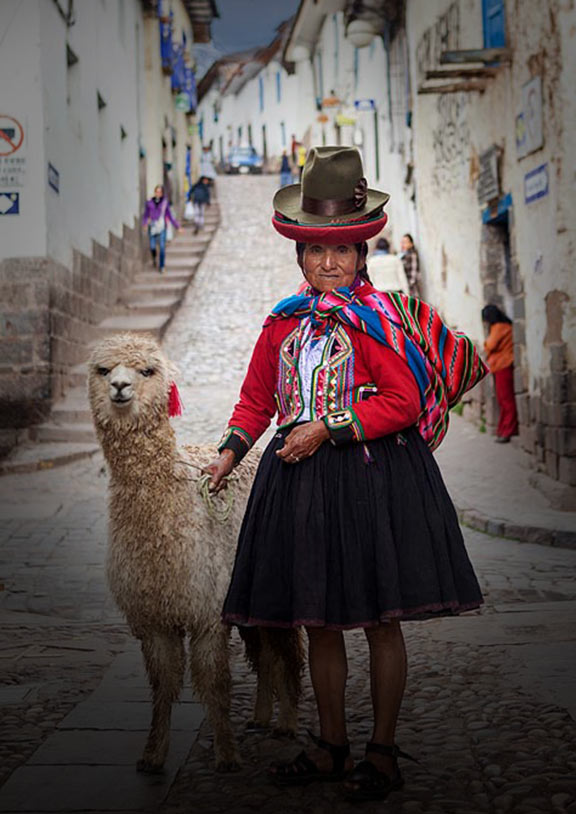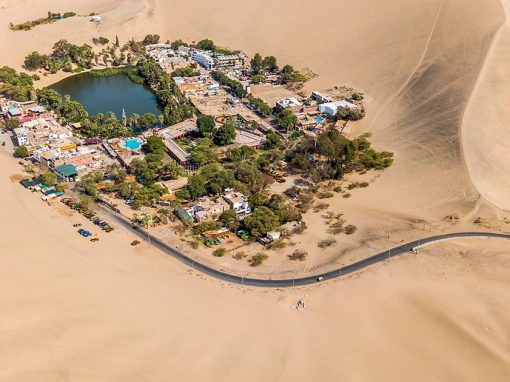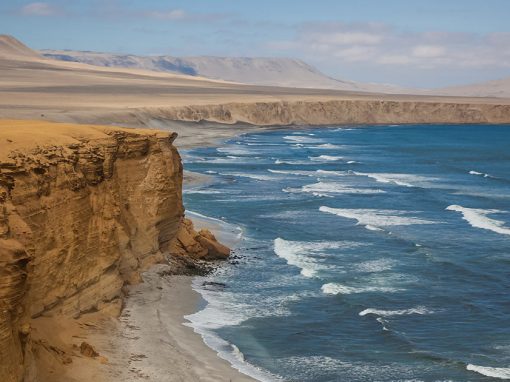These fourteen incredible deserts in South America (not to be confused with South American desserts) are sure to impress. While the region is better known for the Amazon Rainforest and the Andes Mountains, you shouldn’t overlook the picturesque deserts on your next South American vacation.
Covering about a seventh of the earth’s surface, desert landscapes vary from sandy to icy and hilly to flat. Yet they all have one thing in common: they are extremely dry. A desert is technically a place with an average of 10 inches (25 centimeters) or less of annual rainfall. Their barren landscapes provide spectacularly beautiful scenery, as well as many adventure activities.
Table of Contents
- Atacama Desert (Chile)
- Salar de Uyuni (Bolivia)
- Peruvian Coastal Desert (Peru)
- Patagonian Desert (Argentina and Chile)
- Lençóis Maranhenses (Brazil)
- Salinas Grandes (Argentina)
- Sechura Desert (Peru)
- Salvador Dalí Desert (Bolivia)
- Tatacoa Desert (Colombia)
- Monte Desert (Argentina)
- Jalapão State Park (Brazil)
- Dunes of Cabo Polonio (Uruguay)
- Médanos de Coro (Venezuela)
- Guajira Desert (Colombia and Venezuela)
Last updated by Melissa Dreffs in August 2020.
1. Atacama Desert, Chile
Chile is home to the most well known desert in South America: the Atacama Desert. Located along the coast of Northern Chile, it offers incredible, breathtaking landscapes. On an Atacama Desert tour, you can see the area’s main attractions. Astounding volcanoes overlook the largest salt flat in South America, the Salar de Atacama. In addition, another impressive site is the Valle de la Luna, or Moon Valley. With terrain that looks similar to the moon, it truly feels out of this world.

Sand and hills of the Atacama Desert.
Despite being the driest desert in South America, Atacama has a variety of wildlife, including flamingos, coots, and even Humboldt penguins. You’re most likely to spot them congregated near the coast or around small lagoons. In addition to birds, the region provides ample opportunities to see colorful rock strata, impressive geysers, and picturesque towns. Additionally, Atacama has some of the best stargazing skies in the world. Chile’s Atacama Desert draws many scientists and astronomers with the area’s remarkably clear skies. And surprisingly, this desert is home to around a million people, as well.
Read more about the Atacama Desert here.

Atacama desert. Photo by Marcus Dall Col on Unsplash.
2. Salar de Uyuni, Bolivia
This salt desert may change your notion of deserts altogether. Located in Bolivia’s southwest corner, this immense, sparkling sea of salt is beautifully blinding. At a lofty height of 11,985 feet (3,653 meters) above sea level, the Salar de Uyuni travelers should look out for altitude sickness.

Cacti and rocks in the Uyuni desert. Photo by Robin Noguier
on Unsplash.
The salt desert is massive, measuring at 4,633 square miles (12,000 square kilometers). However, Uyuni was once a prehistoric salt lake that covered most of southwest Bolivia. It dried up and its remains created a beautiful geographic feature of their own—today’s spectacular Salar de Uyuni. This otherworldly Bolivian landscape is speckled with flamingos and colorful lagoons like the red Laguna Colorada and the jade green Laguna Verde. When you stand with your back to the vibrant lakes and gaze to the horizon, all you can see for miles is one giant expanse of endless white salt.
Take a look at our Uyuni travel guide here and don’t forget to bring some props for unique perspective photos!

Moon over the Uyuni salt flats. Photo by Regina Calvo
on Unsplash.
3. Peruvian Coastal Desert, Peru
There is a continuous desert along South America’s Pacific coast. This desert stretches from the Sechura Desert in Northern Peru to the Atacama Desert in Chile. While there is little consensus on the name for the area between the Sechura and Atacama Deserts, it is nonetheless spectacular. Some call it the Tacama, Paracas, or Nazca Desert, and others consider it an extension of the Atacama Desert. Whatever the name, this area is home to an impressive amount of history, culture, and adventure.

Rolling dunes along the Peruvian Coastal Desert. Photo by Ana Castañeda for Peru for Less.
With the impressive Andes Mountains as its neighbor, many travelers often overlook Peru’s coastal desert. But with the mysterious Nazca Lines and the charming cities of Paracas, Nazca and Ica, this area is a must-see. Just a few hours south of Lima, these attractions—as well as the Paracas National Reserve and the Ballestas Islands—are easy to reach. Visitors can easily combine a Paracas tour and Nazca tour with other Peruvian destinations.
While in the area, travelers can also visit the Huacachina oasis, just outside of Ica. With its relaxed vibe and cool lagoon surrounded by lush vegetation, Huacachina is a great place to take it easy. This area is also famous for its dune buggies and sand boarding.

Dune buggy in the Peruvian Coastal Desert. Photo by Ana Castañeda for Peru for Less.
4. Patagonian Desert, Argentina and Chile
Argentina and Chile’s Patagonian Desert is the largest desert in South America and eighth largest in the world. Patagonia covers a vast area of land at the south of the continent between the Andes Mountains and the Atlantic Ocean. Close to Antarctica, the Patagonian Desert offers a similar icy barrenness found at the bottom of the world. In this cold, winter desert, the average temperature is around 37 degrees Fahrenheit (3 degrees Celsius).

Patagonian Desert landscape. Photo by Birger Strahl on Unsplash.
The Patagonian Desert, also known as the Patagonian Steppe, is sparsely populated by humans, but several animals exist within its reach. Guanacos, a relative of llamas, rheas, pygmy armadillos, and the Patagonian gray fox are just some of the local residents. The majority of people living in this expansive desert earn a living by raising livestock, such as sheep and goats. Learn more about Patagonia here.
5. Lençóis Maranhenses, Brazil
While not technically a desert, the incredible Lençóis Maranhenses National Park in Brazil certainly deserves a mention. With 47 inches of rain a year, it is too rainy to be considered a true desert, but the rolling white dunes can certainly make us think otherwise.

Lençóis Maranhenses in Brazil.
The blinding white dunes stretch for miles. The little bit of rain the area does get comes from January to June. As a result, thousands of crystal clear lagoons form in the valleys between the dunes. Even though they only exist for a few months, some wildlife call these pools their summer home. However, once the dry season returns and the sun starts drying the pools up again, the fish and other creatures head back to the rivers or burrow underground to sustain themselves until the next summer. The best time to visit Lençóis Maranhenses is between July and September, when the pools are at their most impressive and temperatures are moderate.

Lençóis Maranhenses dunes next to the river and forest.
6. Salinas Grandes, Argentina
This expansive white salt desert, Salinas Grandes, sits in the Jujuy and Salta provinces of Northern Argentina. While Salta is a destination itself, heading out of the city to explore the salt flats is a must. This excursion often includes a visit to Purmamarca, a quaint, small town with views of the Hill of Seven Colors. If you can’t make it to Peru’s Rainbow Mountain, this is a comparable alternative.

Purmamarca’s view of the Hill of Seven Colors. Photo by Hector Ramon Perez on Unsplash.
This journey zigzags through the Andes Mountains on the only road that leads to the impressive Salinas Grandes. On this route, ascend to a maximum peak of 13,680 feet (4,170 meters) above sea level before arriving at the salt flats.

Salinas Grandes salt flats. Photo by Sofia Truppel on Unsplash.
7. Sechura Desert, Peru
In the north of Peru, you can find the Sechura Desert. This desert lines the coast from Piura to Lambayeque and is home to some of the best beaches in Peru. Although a desert, water is not a stranger in these lands. Several rivers run through the desert to reach the Pacific Ocean. These rivers were a key for the success of ancient desert cultures, like the Moche and Sican. This desert also sees rain and floods during the El Niño phenomenon.

Peru’s Sechura Desert. Image: Playa Cangrejos – Piura” by Javier Tavara, used under CC BY 2.0 / Compressed from original
The region is well known for growing algarrobos. This is a type of mesquite tree whose pods can be ground into a rich molasses known as algarrobina. Algarrobina drinks, including a pisco-based cocktail known as cóctel de algarrobina, are very popular in this region of Peru. Across the country, people use algarrobina in smoothies, desserts, baked goods, and as syrup.

Piura, a town in the Sechura Desert. Image: Piura Paita” by Incacity, used under CC BY-SA 2.0 / Compressed from original
8. Salvador Dalí Desert, Bolivia
Salvador Dalí Desert, also known as Dalí Valley, gets its name from the surreal landscapes that look like they belong in a Dalí painting. This vast area of land has a wind-swept, barren look, similar to the backgrounds of many of his paintings, including his most well known painting, The Persistence of Memory, for example.

Salvador Dalí Desert in Bolivia. Image: SalvadorDaliDesert” by Albert Backer, used under CC BY-SA 3.0 / Compress from original
One of the greatest highlights of this desert is the impressive Stone Tree, or Árbol de Piedra in Spanish. Wind and sand eroded this stone into an impressive shape resembling a tree. The desert sits in the Potosi department of Bolivia, the same region as the Uyuni salt flats. Visitors can easily visit both on the same tour.
So, did this Bolivian desert inspire Dalí’s work? Maybe! Take a look at some comparisons between his art and the desert here.

The Árbol de Piedra, a rock formation in the Salvador Dalí Desert. Image: Arbol de la Piedra, Bolivia” by Pedro Szekely, used under CC BY-SA 2.0 / Compressed from original
9. Tatacoa Desert, Colombia
Of the two deserts in Colombia, the Tatacoa Desert is actually the smallest, spreading across just 205 square miles (330 square kilometers). However, it sees a large number of tourists due to the unique landscapes and activities it offers. You can find this desert around the small town of Villavieja in the El Huila department.

Tatacoa Desert in Colombia. Image: Tatacoa Desert” by Laurent de Walick, used under CC BY 2.0 / Adjusted brightness and compressed from original
Tatacoa has two distinct zones, each with their own color. One zone, Los Hoyos, has gray toned stones and sand, while the other zone, known as Cuzco, is red. Due to the eroded rock formations and barrenness, it might feel like the moon and Mars respectively. With little light or noise pollution, the Tatacoa Desert is also a tranquil place for astronomers and stargazers. An observatory in the desert is open to the public close to most hotels in the area.

The dunes and flora of the Tatacoa Desert. Image: The Tatacoa Desert” by Jorge Lascar, used under CC BY 2.0 / Adjusted brightness and compressed from original
10. Monte Desert, Argentina
North of the Patagonian Desert and southeast of the Atacama Desert sits the Monte Desert. In the heart of Argentina’s wine country, this desert has a large river, the Colorado River, and its tributary, the Desaguadero, that help with irrigating the vineyards.

Rock formations in the Monte Desert. Image: Ischigualasto a todo color” by Pedro Reyna, used under CC BY 2.0 / Adjusted brightness and compressed from original
The desert lines are not 100 percent defined with the Patagonian and Atacama Deserts. Together, they create a seemingly endless, massive desert in South America. However, the Monte Desert is different as it has more habitable and supports more varied wildlife than their neighbors. Some creatures that call this desert home are armadillos, cougars, and various rodents.

Argentina’s Monte Desert. Image: PB141166” by t_y_l, used under CC BY-SA 2.0 / Adjusted brightness and compressed from original
11. Jalapão State Park, Brazil
In the remote Tocantins region of Brazil, you can find the Jalapão State Park. This is an interesting destination with dunes, mountains, and waterfalls all in the same area. The orange Espírito Santo dunes reach up to 100 feet (30 m) in height! Fervedouro, Jalapão’s oasis, has a large, transparent lagoon surrounded by banana trees. While in the area, be sure to check out the incredible cascading waterfalls nearby!

Jalapão dunes backing up to the forest. Image: O pôr do Sol nas Dunas do Jalapão
From Palmas, the main city in the area, the state park is about four hours away. 4×4 vehicles are best equipped to handle the terrain. This destination is rather off the beaten path, but can be combined with a visit to Rio de Janeiro, São Paulo, or any of our top destinations in Brazil.

Jalapão Desert in Brazil. Image: Jalapão Dunes – Dunas do Jalapão” by A. Duarte, used under CC BY-SA 2.0 / Compressed from original
12. Dunes of Cabo Polonio, Uruguay
Cabo Polonio is a small fishing town on Uruguay’s Atlantic coast. Due to harsh living conditions, only 100 or so people call Cabo Polonio home. However, a large colony of sea lions also live in this area. Depending on the time of year, whales and dolphins might also be nearby.
In addition to the wildlife, this town is home to a dune system that spreads across 24 square miles (40 square kilometers). Among the smallest deserts in South America, this is the largest desert in Uruguay. The dunes reach up to 100 feet (30 meters) in height and offer unique panoramic views of the sea and islands from the top. The Cerro Buena Vista, or Good View Hill, is the tallest dune in the area. As the name suggests, the view from the top is impressive.

Beaches of Cabo Polonio, Uruguay. Photo by LolaSeillet on Pixabay.
13. Médanos de Coro, Venezuela
A national park in Venezuela, Médanos de Coro is on the Caribbean coast. Rolling dunes stretch for miles and are constantly changing with the strong winds. Similar in appearance to the Sahara Desert, these dunes are perfect for sand boarding, and other activities.

Médanos de Coro Desert in Venezuela. Image: Medanos de Coro, Venezuela” by Carlos Adampol Galindo, used under CC BY-SA 2.0 / Compressed from original
Vegetation is scarce, and what does grow is often buried as the sand blows. However, 21 bird species live in the park. One of the best known is the yellow-shouldered Amazon parrot. Because of this variety, the area has been designated as an Important Bird Area.

Dunes of Médanos de Coro, reminiscent of the Sahara Desert. Image: Medanos de Coro, Venezuela” by Carlos Adampol Galindo, used under CC BY-SA 2.0 / Compressed from original
14. Guajira Desert, Colombia and Venezuela
The Guajira Desert along the Colombian coast offers impressive dunes, salt flats, and beaches. Home to the Wayuu indigenous group, the desert has two large rivers that are their main source of water. Above all, this group is known for its intricate weaving styles, so textiles from this area make incredible souvenirs.

The Guajira Desert in Colombia and Venezuela. Image: Guajira Colombiana” by Luis Perez, used under CC BY 2.0 /Compressed from original
Accommodation and transportation around this desert are not for the faint of heart. Be prepared for a very rustic stay with limited running water and electricity. However, if you can overcome this, the Guajira Desert is sure to impress with the endless picturesque views.

The Guajira Desert along the Caribbean Sea. Image: La Guajira” by Axel Rouvin, used under CC BY 2.0 / Compressed from original
We recommend checking out at least one of these remarkable deserts in South America during your next trip. To start planning a South American desert adventure, contact one of our Travel Advisors who can customize a travel package that’s right for you.
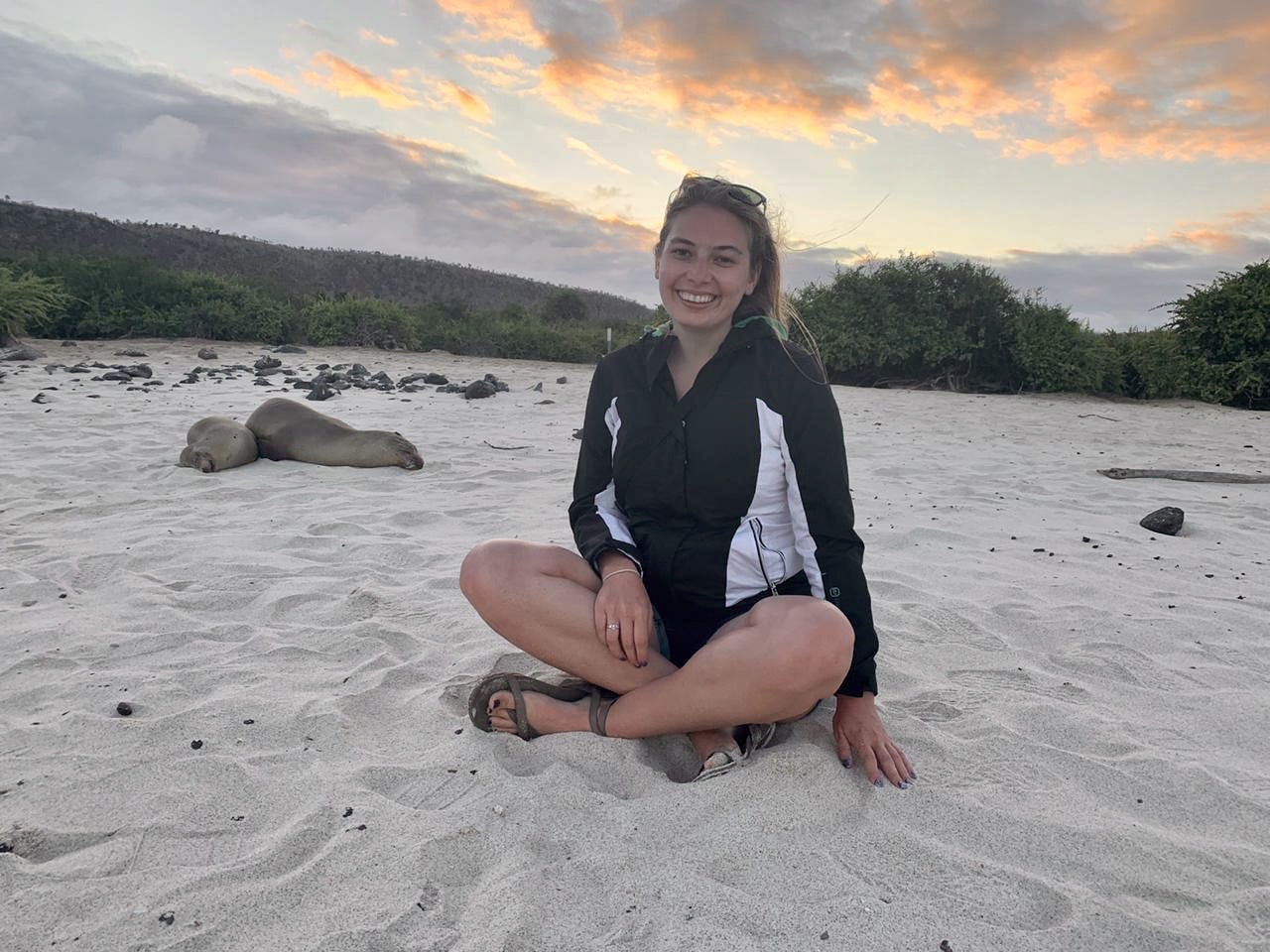
Born and raised in small town Michigan, Melissa began traveling at 15 and hasn’t stopped since. After calling Havana and Paris her temporary homes, she moved to Lima in 2018. Since then, she has traveled extensively in Peru and across the continent to Argentina, Brazil, Chile, Ecuador and the Galapagos Islands. She loves trying new foods, learning about history, and chasing waterfalls.



